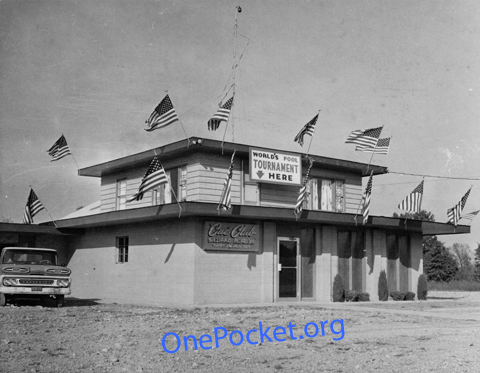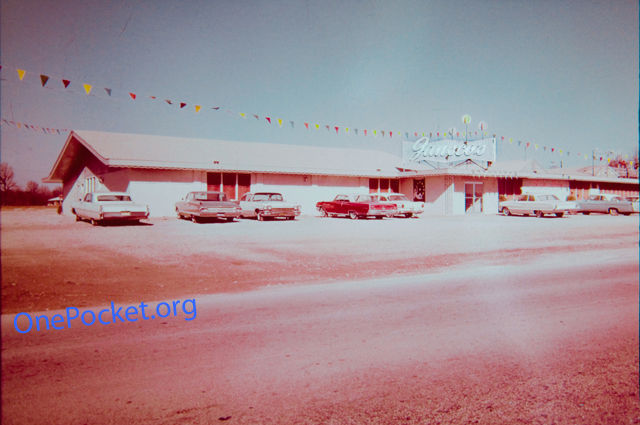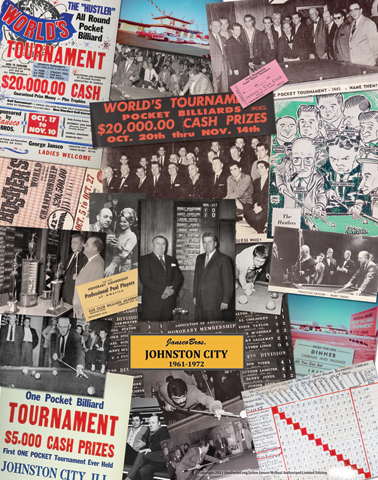 |  | ||||||||||
| |||||||||||
| October, 2011 The Jansco Bros. Johnston City Tournaments 50th Anniversary, 1961-2011 October 25th, 1961 the world of pool in America woke up to a remarkable new kind of tournament that shook the pool establishment out of a deep slumber. It was an unusual event on several fronts; one being the unlikely location for a major national pool tournament, deep in rural southern Illinois. Second, it was a game, One Pocket, not recognized by the established sanctioning body of pool in America at that time, the Billiard Congress of America. Third, the tournament boldly featured a number of known hustler pool players who had not participated in the few sanctioned events of the mid-century -- whether by their own choice, or because they were not invited due to their reputations. And finally, the promoter was a total newcomer to pool tournament promotions, a fellow who had his own roots more in the gambling side of pool than the establishment side of pool, the remarkable George Jansco. So who were these Jansco Brothers, and what made them think a small town in southern Illinois could become the “Billiard Capitol of the World”?
George was a very good pool player himself, so in about 1959 George purchased a 9’ Macon (later named Gandy) pool table which he placed in the small building in back of the J&J Ranch, along with an old couch on one wall that was raised up so invited onlookers could watch the action. It was his own personal one table poolroom. It was here that he hosted road players like ‘Fats’ (who was living in Dowell, about an hour away), Hubert Cokes (who was from Evansville, IN, about an hour away the other way), Marshall ‘Squirrel’ Carpenter, Eddie Taylor, Bill ‘Weenie Beenie’ Staton, Earl Schriver and others. It was around that table, or at the J&J bar, that George’s tournament idea was originally hatched. George always dreamed big, and he envisioned his 2500 acres of land as the ideal stopping off point along route 57, where eventually he and Paulie would have the Show Bar, a golf course and even a hotel to serve every kind of need for those who stopped along this major route between the South and Chicago. The Jansco's Show Bar came first, and George opened the Stardust Golf Course in 1968, and when he died in 1969 he was just finalizing the hotel plans. George was very innovative and energetic, so between he and Paulie there were many significant firsts or near firsts in the world of pool tournaments at Johnston City. During the summer of 1961, out behind their nightclub, George & Paulie built The Cue Club for the purpose of holding the first tournament. The new building’s main arena was designed to seat 200 spectators. This appears to have been the first time a building was built specifically to host a pool tournament. George mailed out many posters with cover letters to introduce this tournament. He used his considerable experience and success as a local sports promoter to “get the word out.” It was his first pool tournament, but it was far from his first promotion, and he approached that first tournament with a lot of confidence.
Emboldened by the success of the first tournament, for the second year (1962) George expanded the tournament from just One Pocket to the unique all-around format that became the hallmark of his tournaments, including Straight Pool and 9-Ball along with One Pocket. This was one of the first professional 9-Ball tournaments ever held, if not the first, and it was also the first all-around pool tournament. For ‘62 George pledged $10,000 in prizes. The tournament opened with a challenge match between Johnston City mayor Neil Thurmond and Herrin mayor Fred Henderson. This was the kind of promotional detail that George was so good at, and it undoubtably helped promote “legitimacy” with the two local mayors in attendance. All three divisions ran concurrently, which stretched out each discipline so that even if you were playing only in one division, you might need to stay the entire three weeks. The ’62 event was the first US integrated professional pool tournament, including black player Javanley 'Youngblood' Washington. In 1963, the Jansco Brothers continued the same all-around format that was one of the hallmarks of Johnston City, with a $10,000 prize fund again. After a scouting mission on November 14, CBS came to Johnston City to cover the finals, which was the first time major TV covered either a 9-ball or One Pocket pool tournament. Following the success of the 1963 tournament and the excitement of having national TV coverage, George went to work making bigger and better plans for the next tournament. For the 1964 event, he and Paulie built an addition to the Show Bar, the first ever specially built pool tournament theatre (“The Pit”) in time for the ’64 tournament. A bidding war between CBS and ABC netted George a paid TV contract with ABC 'Wide World of Sports' for $8000, which helped boost the 1964 prize fund to $20,000. The BCA also sanctioned Johnston City for the first time that year, and the billiard press talked about George Jansco having “gone respectable.” Brunswick provided 4 tables, two of which were utilized in the pit. Prior to the ’64 event, George consulted with a lighting expert to design special large black curtain-skirted light boxes over the two feature tables, which he kept burning all night to avoid changes in the playing conditions. These unique lights provided unprecedented shadow-free table illumination, yet the deep canopies left the large crowds in shadow so the players could better focus on the match at hand. In 1965 George established the first modern player organization, the Billiard Players Association of America with the goals of improving tournaments, better promotion, more favorable image and greater status for players and most importantly, no restrictions on what tournaments players could enter. In 1966 the format was changed so that each division was held in a separate week to ease player’s travel concerns. The all-around champion format stayed the same. In 1967, for the first time, 9-Ball was played “On any foul (except the break), opponent may place the cue ball anywhere on the table.” In prior years, “push-out” was the standard for 9-Ball. Another innovation for ’67 was the first ever Amateur event in conjunction with the pro tournament at Johnston City. In 1968, George first began to include “Hustler” on his posters; although he was always hustler-friendly, he had generally left that label to the media, preferring instead to focus on lifting the image of the sport.
On June 4, 1969, George died of a “massive cerebral hemorrhage”, the very day that he had finalized plans to build his long dreamed of hotel.From 1969 on, Paulie took over running the JC and Stardust tournaments. In 1970 there was a serious youth invasion, including young guns Cole Dickson & Jim Mataya in attendance, but it was unheralded 18-year-old Keith Thompson who won both the 9-Ball and the all around title that year. In 1971 Evelyn Dal Porto became the first woman entered at Johnston City, competing on equal footing with the men. In 1972 Paulie tried a spring Johnston City tournament with disappointing results. This was the only spring Johnston City tournament. The spring event also featured a women’s event, which was won by a young Jean Balukas. For what turned out to be the final Johnston City tournament in the fall of 1972, Paulie dropped Straight Pool, so this final tournament consisted only of One Pocket and 9-Ball. Including the spring “Tournament of Champions”, this came to a total of 13 Johnston City events. Only two players competed in every single one – Larry ‘Boston Shorty’ Johnston and Hubert ‘Daddy Warbucks’ Cokes. The fed’s (IRS, with the support of the Illinois Bureau of Investigation & Illinois State Police) raided the tournament for gambling early in the morning of Oct 26th, after seeing “newspaper reports of large-scale gambling taking place at the tournament.” The raid derailed the schedule for finishing the tournament, which had to be extended into the following week. Afterwards, Paulie railed against the press for lack of tournament coverage and vowed never to hold another tournament in Illinois – marking the end of an era for the Jansco’s and Johnston City. It should be noted that all reports indicate that the Jansco Brothers always paid out completely what they had promised in prize money – a fulfillment of commitment to the players that unfortunately has often been lacking among tournament promoters, even in recent years. After he retired from tournament promotion, Paulie once signed the back of a promotional photo, "I promoted more pool tournaments than anyone else on earth. I gave away more prize money than all of the other promoters combined."
All photos property of Joann McNeal All text ©2011 Steve Booth OnePocket.org Special thanks to Johnston City aficionados Gardner Washburn and the late Jerry Novak for their help with research All rights reserved.
| |||||||||||||||||
Web Design by J Maze Design











